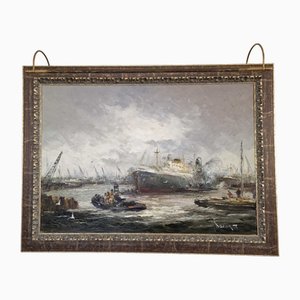Traducción generada automáticamente
Mostrar original
Mostrar traducción
William Edward Webb.
English ( b.1862 - d.1903 ).
Peel Harbour, Isle Of Man.
Oil On Canvas.
Signed Lower Left.
Image size 21.5 inches x 37.4 inches ( 54.5cm x 95cm ).
Frame size 33.5 inches x 49.8 inches ( 85cm x 126.5cm ).
Available for sale from Big Sky Fine Art in the English county of Dorset, this original oil painting is by the English marine artist William Edward Webb and dates from the 1890s.
The painting is presented and supplied in its original frame (which is shown in these photographs) fitted with new fixtures.
The frame and the painted surface of the canvas has benefitted from restoration, cleaning and conservation, all of which was performed on our instruction, supervision and approval.
This antique painting is now in very good condition. It wants for nothing and is supplied ready to hang and display.
The painting is signed lower left.
William Edward Webb was an English Victorian artist who specialised in coastal scenes from around the British Isles. His work has found particular recognition in recent years.
The son of William Benjamin Webb and Ellen Butler, he was born in Cheltenham, Gloucestershire in 1862. His father was an artist, and it is likely that he received tuition from him at an early age. Following the death of his mother his father re-married and the family moved to Manchester, where William lived for the rest of his life.
Webb initially set up his studio in Exchange Buildings in Manchester and was working full time as an artist by the 1880s. He first exhibited at the Manchester Art Gallery in 1890 and went on to show more than 60 paintings there during his lifetime. He also exhibited with the Walker Art Gallery in Liverpool and three times at the Royal Academy in London. Respected by his peers, he was elected an Associate of the Academy of Fine Arts in Manchester in 1889.
In 1899 Webb married Clara Foster and they had a daughter, Florrie. The family lived in Chorlton Upon Medlock in South Manchester, although Webb travelled extensively as he increasingly specialised in coastal art. He is known to have painted in Scotland, Yorkshire, Lancashire, Gloucestershire, Northumbria, Dorset and Hampshire. He was particularly fond of the Isle of Man where he spent a great deal of time, and he painted the harbours there with the insight of a local.
Webb tended to work in oils, and his style was flowing and detailed. He showed a real mastery of the sea, which he usually depicted as vibrant and active and his use of light is exceedingly realistic. His works are a testament to the hard lives of the people who made their living from the coast, particularly the sailors and fishing families. He portrayed their lives with dignity and without being overly romantic or showing false glamour.
Sadly, Webb struggled with ill health and depression for much of his life and this led to his suicide on 9th November 1903.
Although Webb had an impressive output during his life and saw some modest success commercially, his paintings have become more popular since his death. The author Denys Brook-Hart appreciated Webb as an artist and organised a large retrospective exhibition of his works in 1974 at the Old Customs House and Old Solent House Galleries in Lymington, Hampshire. Since then, his works have gained increased recognition and value.
Webb’s original works are now highly sought after and are represented in many collections and museums including the Tuille House Museum, Astley Hall Museum, Harris Museum, Manchester Art Gallery, Manx Museum, Middlesborough Institute of Modern Art and Shipley Art Gallery.
This original oil on canvas painting by William Webb is signed by the artist in the lower left corner. It depicts a busy scene in Peel Harbour on the Isle of Man. Webb’s mastery of coastal scenes is evident in the detailed portrayal of boats resting on the shore at low tide, with the calm waters of the Irish Sea in the background. The composition features a quaint harbour village with stone houses and fishing boats scattered along the dock. The earthy tones of the harbour, combined with the soft blues of the sky and sea, create a tranquil, almost nostalgic atmosphere.
Webb skilfully contrasts the rugged textures of the harbour with the smooth expanse of the horizon, where distant ships sail across the serene waters. The painting exudes a peaceful yet industrious atmosphere, typical of a coastal town where the ebb and flow of tides dictate daily life. This piece is a classic representation of 19th-century British marine art, capturing both the charm and the working nature of harbours like Peel.
The subtle lighting, soft cloud formations, and attention to detail in both architecture and maritime elements make this artwork a significant example of William Webb’s talent in Victorian seascape painting.
William Edward Webb
Inglés ( n.1862 - d.1903 ).
Puerto de Peel, Isla de Man.
Óleo sobre lienzo.
Firmado abajo a la izquierda.
Tamaño de la imagen 21.5 inches x 37.4 inches ( 54.5cm x 95cm ).
Tamaño del marco 33.5 inches x 49.8 inches ( 85cm x 126.5cm ).
Disponible a la venta en Big Sky Fine Art, en el condado inglés de Dorset, este óleo original es obra del artista marino inglés William Edward Webb y data de la década de 1890.
La pintura se presenta y se suministra en su marco original (que se muestra en estas fotografías) equipado con nuevos accesorios.
El marco y la superficie pintada del lienzo han sido restaurados, limpiados y conservados bajo nuestra supervisión y aprobación.
Este cuadro antiguo se encuentra ahora en muy buen estado. No le falta de nada y se entrega listo para colgar y exponer.
El cuadro está firmado en la parte inferior izquierda.
William Edward Webb fue un artista victoriano inglés especializado en escenas costeras de las Islas Británicas. Su obra ha obtenido un reconocimiento especial en los últimos años.
Hijo de William Benjamin Webb y Ellen Butler, nació en Cheltenham, Gloucestershire, en 1862. Su padre era artista, y es probable que recibiera clases de él a una edad temprana. Tras la muerte de su madre, su padre volvió a casarse y la familia se trasladó a Manchester, donde William vivió el resto de su vida.
Al principio, Webb instaló su estudio en Exchange Buildings, en Manchester, y en la década de 1880 ya trabajaba a tiempo completo como artista. Expuso por primera vez en la Manchester Art Gallery en 1890, donde llegó a exponer más de 60 cuadros a lo largo de su vida. También expuso en la Walker Art Gallery de Liverpool y tres veces en la Royal Academy de Londres. Respetado por sus colegas, en 1889 fue elegido miembro de la Academia de Bellas Artes de Manchester.
En 1899 Webb se casó con Clara Foster, con la que tuvo una hija, Florrie. La familia vivió en Chorlton Upon Medlock, en el sur de Manchester, aunque Webb viajó mucho a medida que se especializaba cada vez más en el arte costero. Se sabe que pintó en Escocia, Yorkshire, Lancashire, Gloucestershire, Northumbria, Dorset y Hampshire. Le gustaba especialmente la isla de Man, donde pasó mucho tiempo, y pintó sus puertos con la perspicacia de un lugareño.
Webb solía pintar al óleo, con un estilo fluido y detallista. Demostró un verdadero dominio del mar, que suele representar vibrante y activo, y su uso de la luz es sumamente realista. Sus obras son un testimonio de la dura vida de la gente que vivía de la costa, en particular los marineros y las familias de pescadores. Retrató sus vidas con dignidad y sin ser excesivamente romántico o mostrar un falso glamour.
Lamentablemente, Webb luchó contra la enfermedad y la depresión durante gran parte de su vida, lo que le llevó al suicidio el 9 de noviembre de 1903.
Aunque Webb tuvo una producción impresionante durante su vida y cosechó un modesto éxito comercial, sus cuadros se han hecho más populares desde su muerte. El escritor Denys Brook-Hart apreciaba a Webb como artista y organizó una gran exposición retrospectiva de sus obras en 1974 en las galerías Old Customs House y Old Solent House de Lymington, Hampshire. Desde entonces, sus obras han adquirido mayor reconocimiento y valor.
En la actualidad, las obras originales de Webb son muy codiciadas y están representadas en numerosas colecciones y museos, como el Tuille House Museum, el Astley Hall Museum, el Harris Museum, la Manchester Art Gallery, el Manx Museum, el Middlesborough Institute of Modern Art y la Shipley Art Gallery.
Este óleo sobre lienzo original de William Webb está firmado por el artista en la esquina inferior izquierda. Representa una ajetreada escena en el puerto de Peel, en la Isla de Man. La maestría de Webb en las escenas costeras queda patente en el detallado retrato de los barcos que descansan en la orilla durante la marea baja, con las tranquilas aguas del mar de Irlanda al fondo. La composición muestra un pintoresco pueblo portuario con casas de piedra y barcas de pesca esparcidas a lo largo del muelle. Los tonos terrosos del puerto, combinados con los azules suaves del cielo y el mar, crean una atmósfera tranquila, casi nostálgica.
Webb contrasta hábilmente las rugosas texturas del puerto con la suave extensión del horizonte, donde los barcos lejanos surcan las serenas aguas. El cuadro destila una atmósfera apacible pero laboriosa, típica de una ciudad costera donde el flujo y reflujo de las mareas dicta la vida cotidiana. Esta obra es una representación clásica del arte marino británico del siglo XIX, que capta tanto el encanto como la naturaleza trabajadora de puertos como Peel.
La sutil iluminación, las suaves formaciones de nubes y la atención al detalle tanto en la arquitectura como en los elementos marítimos hacen de esta obra de arte un ejemplo significativo del talento de William Webb en la pintura victoriana de paisajes marinos.
























Contacta con nosotros
Haz una oferta
¡Hemos notado que eres nuevo en Pamono!
Por favor, acepta los Términos y condiciones y nuestra Política de privacidad
Contacta con nosotros
Haz una oferta
¡Ya casi está!
Para seguir la conversación en la plataforma, por favor completa el registro. Para proceder con tu oferta en la plataforma, por favor completa el registro.Exitoso
Gracias por tu consulta, alguien de nuestro equipo se pondrá en contacto contigo en breve.
Si eres profesional del diseño, por favor solicita aquí los beneficios del Programa comercial de Pamono